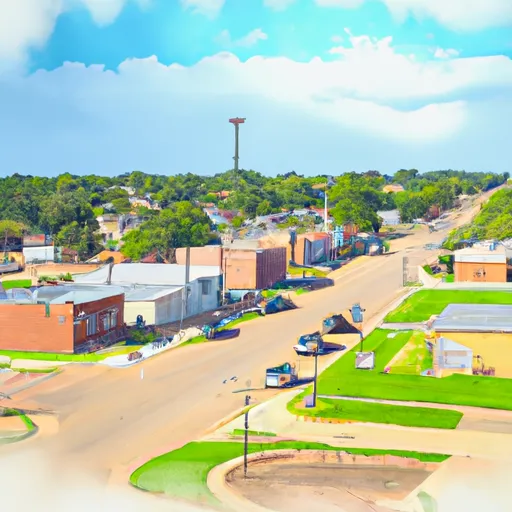-
 Snoflo Premium
Snoflo Premium
Get unlimited access to all our content
With no Ad interruptions! - Start Your Free Trial Login with existing account
Rosston
Eden Index
Climate
9.6
•
Recreation
0.6
•
Community
•
Safeguard
4.0/10

Rosston, Oklahoma is a small town located in Harper County. It experiences a continental climate with hot summers and cold winters. Summers are typically characterized by high temperatures averaging around 90°F (32°C), while winters see temperatures dropping to an average of 31°F (-1°C). Precipitation is evenly spread throughout the year, with an average annual rainfall of around 29 inches (74 cm) and occasional snowfall during the winter months.
Hydrologically, Rosston lies within the Salt Fork of the Arkansas River watershed. This river system provides important water resources for the town and supports various aquatic habitats. The area is also home to small ponds and lakes that enhance the local hydrology and provide opportunities for fishing and boating enthusiasts.
Outdoor recreation in Rosston is mainly centered around its natural surroundings. The nearby Gloss Mountains State Park offers stunning scenic views and opportunities for hiking, camping, and wildlife observation. Additionally, the area's rivers and lakes provide excellent conditions for fishing, while the rolling plains surrounding the town are great for bird watching and nature walks. Overall, Rosston provides a serene and picturesque environment for outdoor enthusiasts to enjoy.
What is the Eden Index?
The Snoflo Eden Index serves as a comprehensive rating system for regions, evaluating their desirability through a holistic assessment of climate health, outdoor recreation opportunities, and natural disaster risk, acknowledging the profound impact of these factors on livability and well-being.
Climate Health Indicator (CHI): 9.6
Rosston receives approximately
577mm of rain per year,
with humidity levels near 72%
and air temperatures averaging around
15°C.
Rosston has a plant hardyness factor of
6, meaning
plants and agriculture in this region thrive during a short period during spring and early summer. Most
plants will die off during the colder winter months.
By considering the ideal temperature range, reliable water supplies, clean air, and stable seasonal rain or snowpacks, the Climate Health Indicator (CHI) underscores the significance of a healthy climate as the foundation for quality living.
A healthy climate is paramount for ensuring a high quality of life and livability in a region, fostering both physical well-being and environmental harmony. This can be characterized by ideal temperatures, reliable access to water supplies, clean air, and consistent seasonal rain or snowpacks.
Weather Forecast
Streamflow Conditions
Upper Cimarron
Area Rivers
Upper Cimarron
Snowpack Depths
Upper Cimarron
Reservoir Storage Capacity
Upper Cimarron
Groundwater Levels
Recreational Opportunity Index (ROI): 0.6
The Recreational Opportunity Index (ROI) recognizes the value of outdoor recreational options, such as parks, hiking trails, camping sites, and fishing spots, while acknowledging that climate plays a pivotal role in ensuring the comfort and consistency of these experiences.
Access to outdoor recreational opportunities, encompassing activities such as parks, hiking, camping, and fishing, is crucial for overall well-being, and the climate plays a pivotal role in enabling and enhancing these experiences, ensuring that individuals can engage in nature-based activities comfortably and consistently.
Camping Areas
| Campground | Campsites | Reservations | Toilets | Showers | Elevation |
|---|---|---|---|---|---|
| Doby Springs Park | 18 | 1,975 ft | |||
| Skipout | 12 | 2,285 ft | |||
| Buckner Valley Park | None | 2,341 ft | |||
| Laverne Municipal Park | 4 | 2,118 ft | |||
| Dodge City Roadside Park | 5 | 2,526 ft | |||
| Jetmore City Lake | 15 | 2,340 ft |
Nearby Ski Areas
Catastrophe Safeguard Index (CSI):
The Catastrophe Safeguard Index (CSI) recognizes that natural disaster risk, encompassing floods, fires, hurricanes, and tornadoes, can drastically affect safety and the overall appeal of an area.
The level of natural disaster risk in a region significantly affects safety and the overall livability, with climate change amplifying these risks by potentially increasing the frequency and intensity of events like floods, fires, hurricanes, and tornadoes, thereby posing substantial challenges to community resilience and well-being.
Community Resilience Indicator (CRI):
The Community Resilience Indicator (CRI) recognizes that education, healthcare, and socioeconomics are crucial to the well-being of a region. The CRI acknowledges the profound impact of these elements on residents' overall quality of life. By evaluating educational resources, healthcare accessibility, and economic inclusivity, the index captures the essential aspects that contribute to a thriving community, fostering resident satisfaction, equity, and social cohesion.

